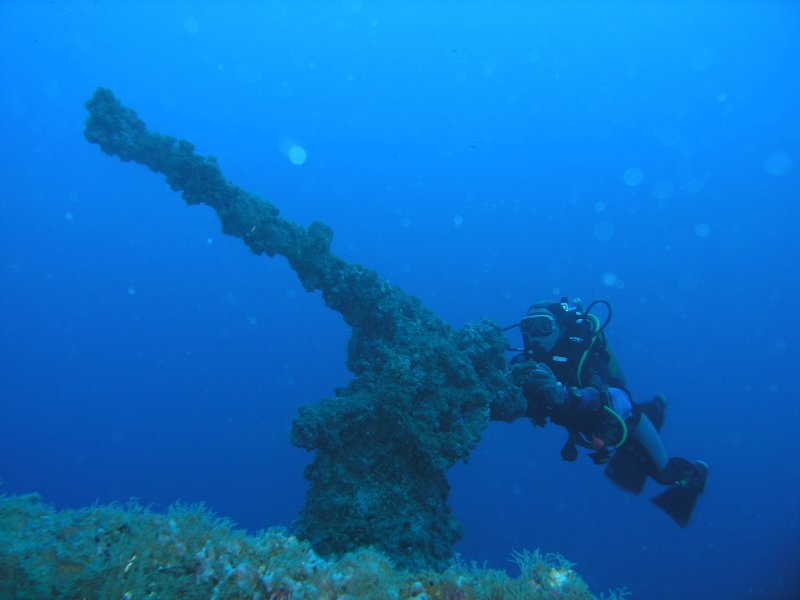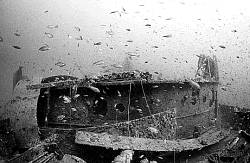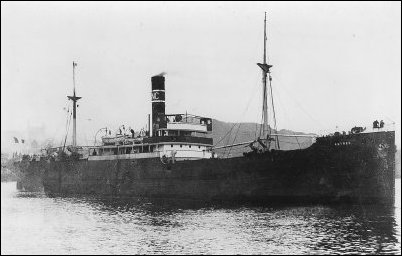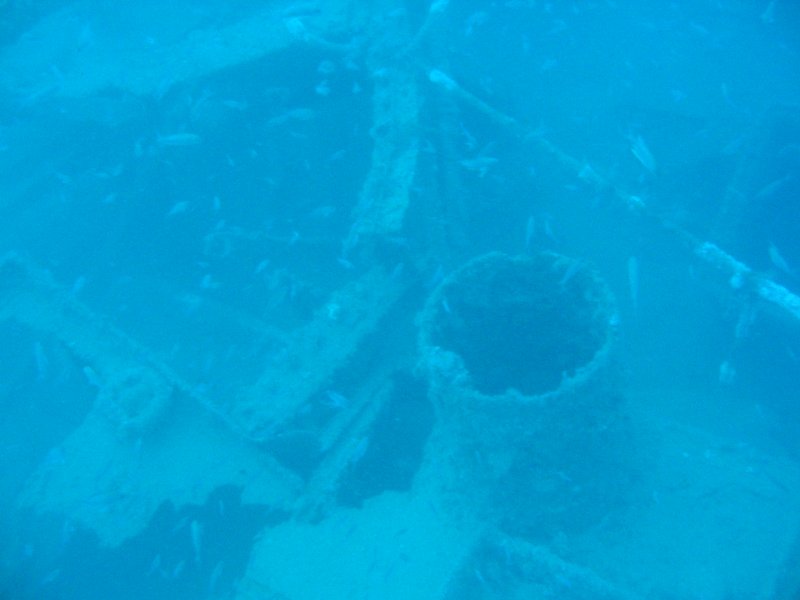- Port Vendres, trade harbor since the Antiquity, offers a natural shelter to the ships sailing to Spain.
- A lot of wrecks, victims of the sea or of the last World War, stand in the Port Vendres Bay and are wonderfull diving sites.

This photo is the photo of Patrice STRAZZERA's cover book "Le Sommeil Des Epaves".
Lots of websites dedicate loads of pages to this diver-writer
To know more about the wrecks, Google it with the keywords Patrice STRAZZERA.
Pitheas: close to the diving center, that little steam boat sank at the beginning of the 20th century and now stands in the 15metres zone, along the beach cliff. The boiler and a bit of the deck can still be seen.
Saumur: a 108-metre-long freighter, built in 1920 in Scotland.
Saumur was first a coaler, then it was allocated to colonial lines. In December 1942 it was caught by the German. In May 1944, Saumur was torpedoed by the English submarine UPSTART.
Saumur is the largest wreck in this area. The deck is still in good condition.
Photo gallery of the Saumur
 |
 |
 |
Alice Robert:
a fruiterer freighter built in 1934 in Denmark. It was 88 metres long and 14 metres wide. For 5 years she had been transporting fruit from French colonies (so her nickname was "The banana boat").
In 1939 it was requisitioned by the National Maritime Company. In December 1942 it was caught by Germany and used to transport troops under the name of SG11.
June, 2nd 1944, it was attacked by the English submarine ULTOR and sunk by a torpedo. The boat was broken into two parts, and 27 German soldiers died.
 Nowadays,the prow lays by a depth of 47 metres and the top of the mast is only by a depth of 20 metres . The stern is 200 metres further South but is less attractive than the prow.
Nowadays,the prow lays by a depth of 47 metres and the top of the mast is only by a depth of 20 metres . The stern is 200 metres further South but is less attractive than the prow.
Alice Robert is one of the most beautiful wrecks of the Languedoc-Roussillon coast.

Astrée:
English coaler, built in 1921. In 1942, this ship is requisitioned by the Germans. On May the 1st of 1944, Astrée, coming back from Egypt, was sunk by a torpedo shot by the British submarine UNTIRING. The ship was broken into two bits and nowadays lays at a depth of 45 metres.
Saint Lucien: it was named after the Danish city where it was built in 1920 : Aalborg (near Copenhagen). It's an 80-meter-long ore freighter. In 1940 it was caught by the English Admiralty then given to France. Its name became Saint Lucien. In 1943, as the ship was in Germans hands, it was sunk by the English submarine UNRULY, near Béar Cape.
Some photos of the Saint Lucien. To display them in 800x600, click on the thumbnail.To come back to this page, shut the window.
Photo gallery of the Saint Lucien
 |
 |
 |
If you want to know more things about these wrecks, you can consult ( in French):

"Le Sommeil Des Epaves" by Patrice Strazzera
"Le Sommeil Des Epaves II (Les Souvenirs)" by Patrice Strazzera
"Le Sommeil Des Epaves III (Mémoires)" by Patrice Strazzera
"Plongée Sur Les Epaves, Guide Technique" by P. Strazzera and François Brun (Les Presses littéraires)
You can find and buy them at Scuba Passion.
Sites you can visit if you wont more information about these wrecks :
http://perso.libertysurf.fr/hlevano/
Dive on an unknown wreck : Ganekogorta-Mendi
http://www.aquanaute.com/ganeko/


